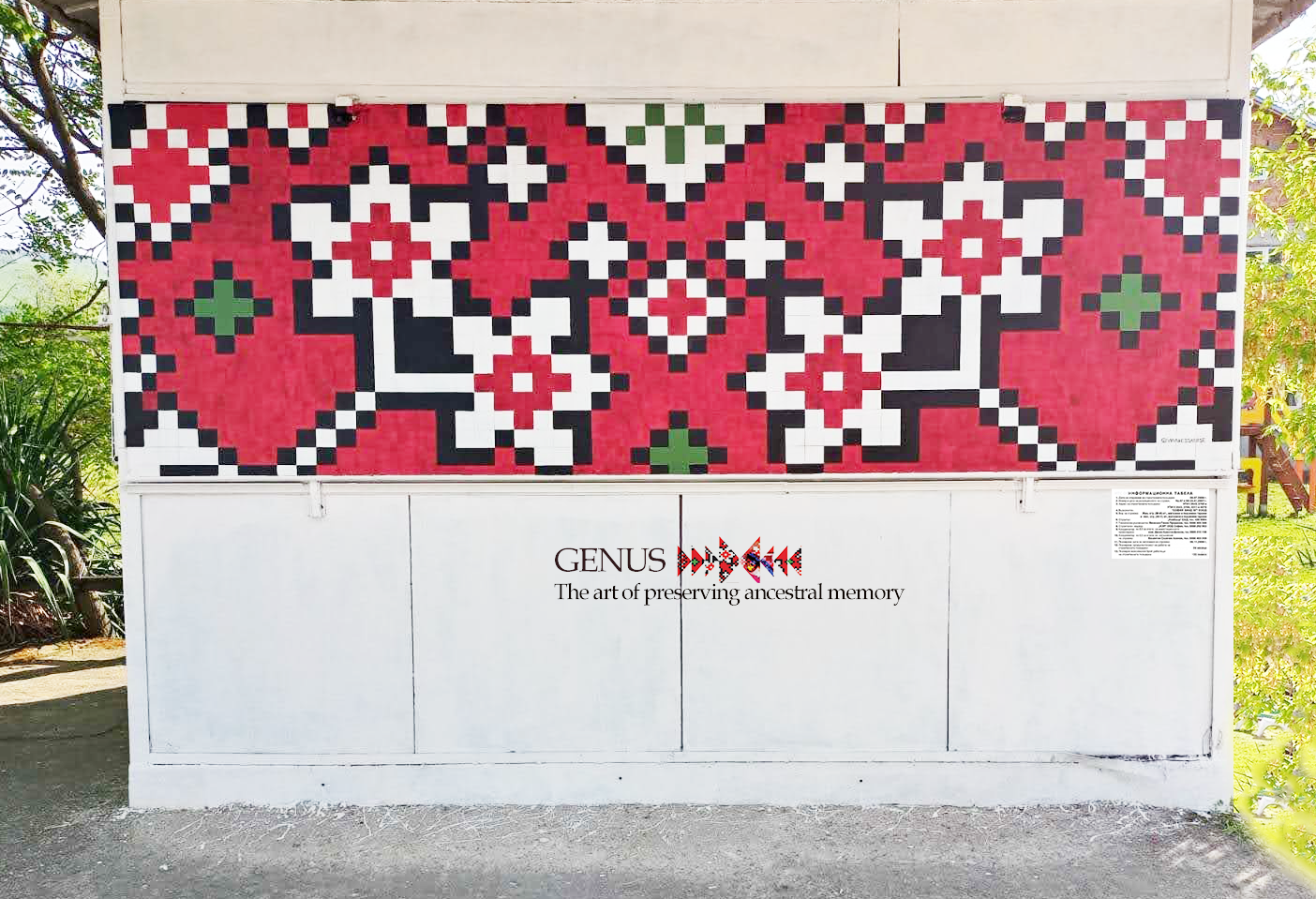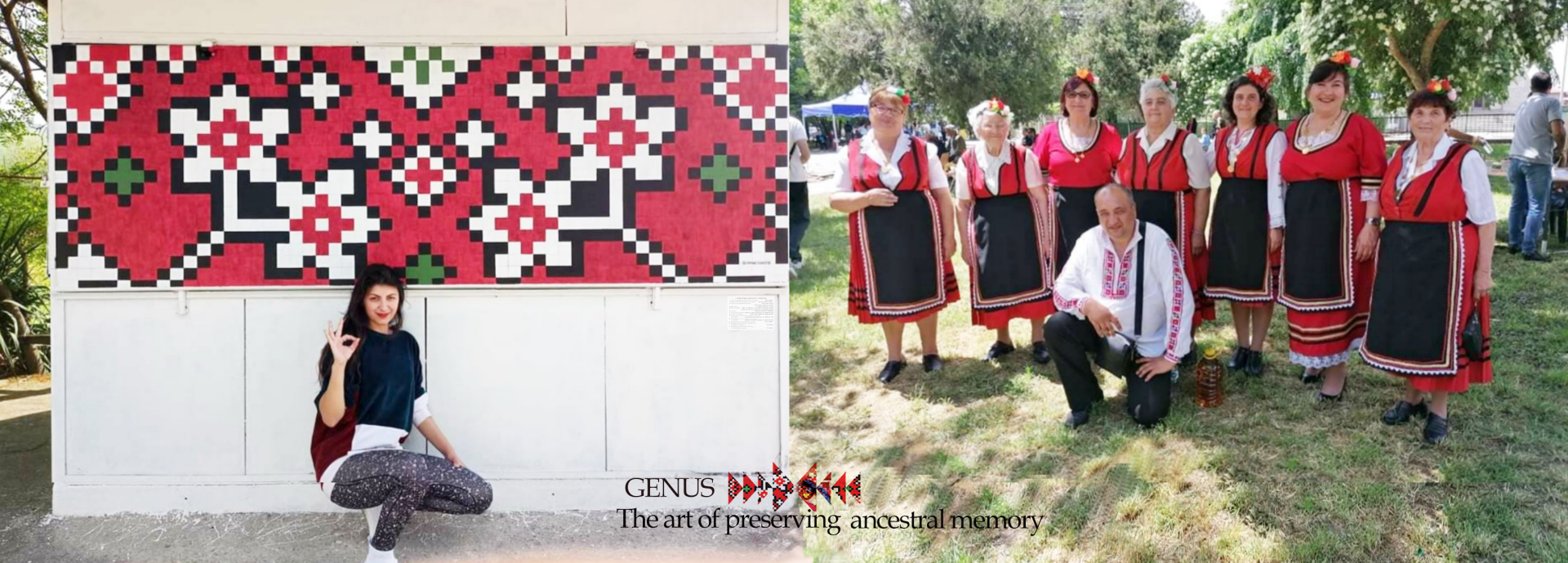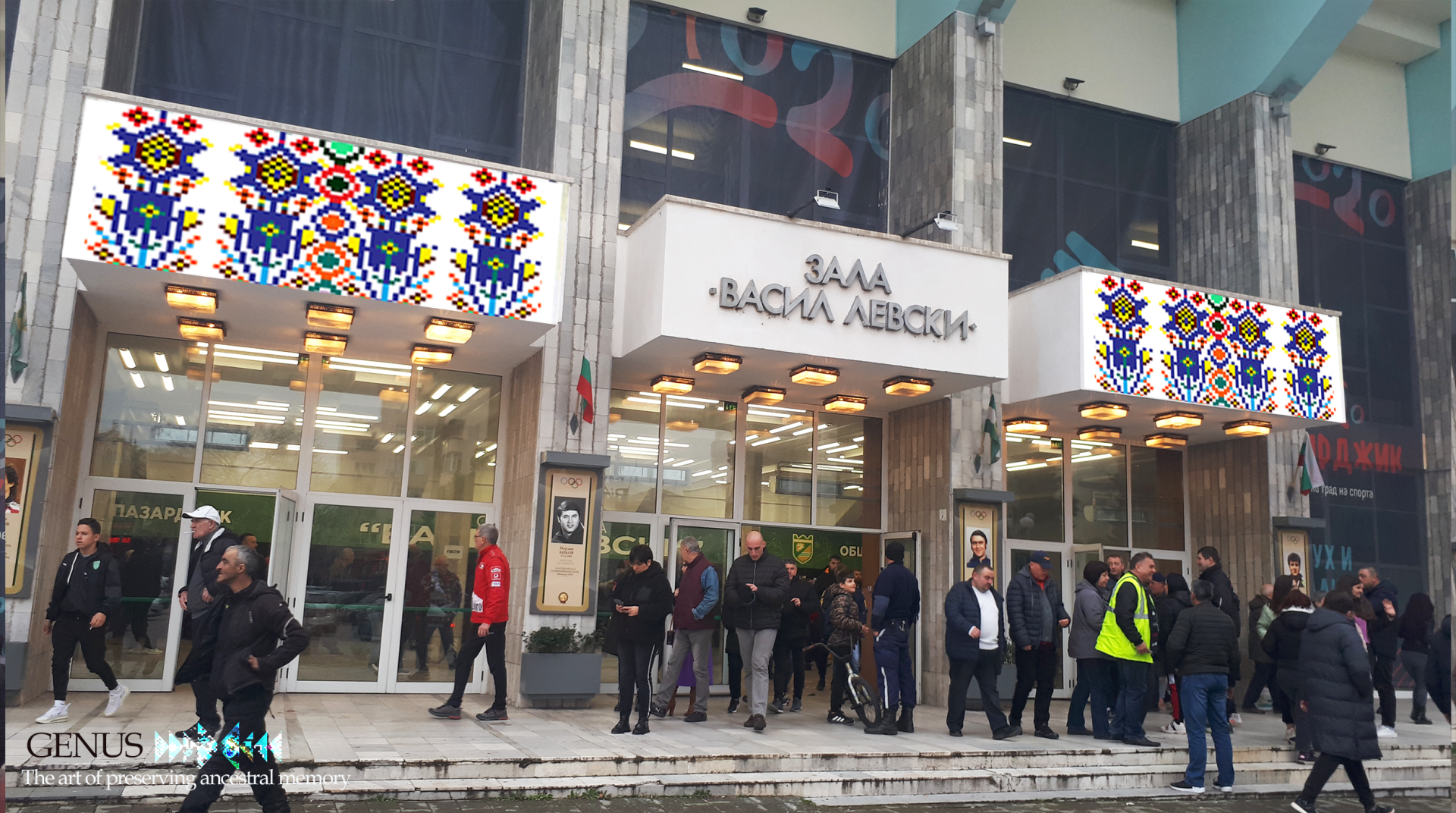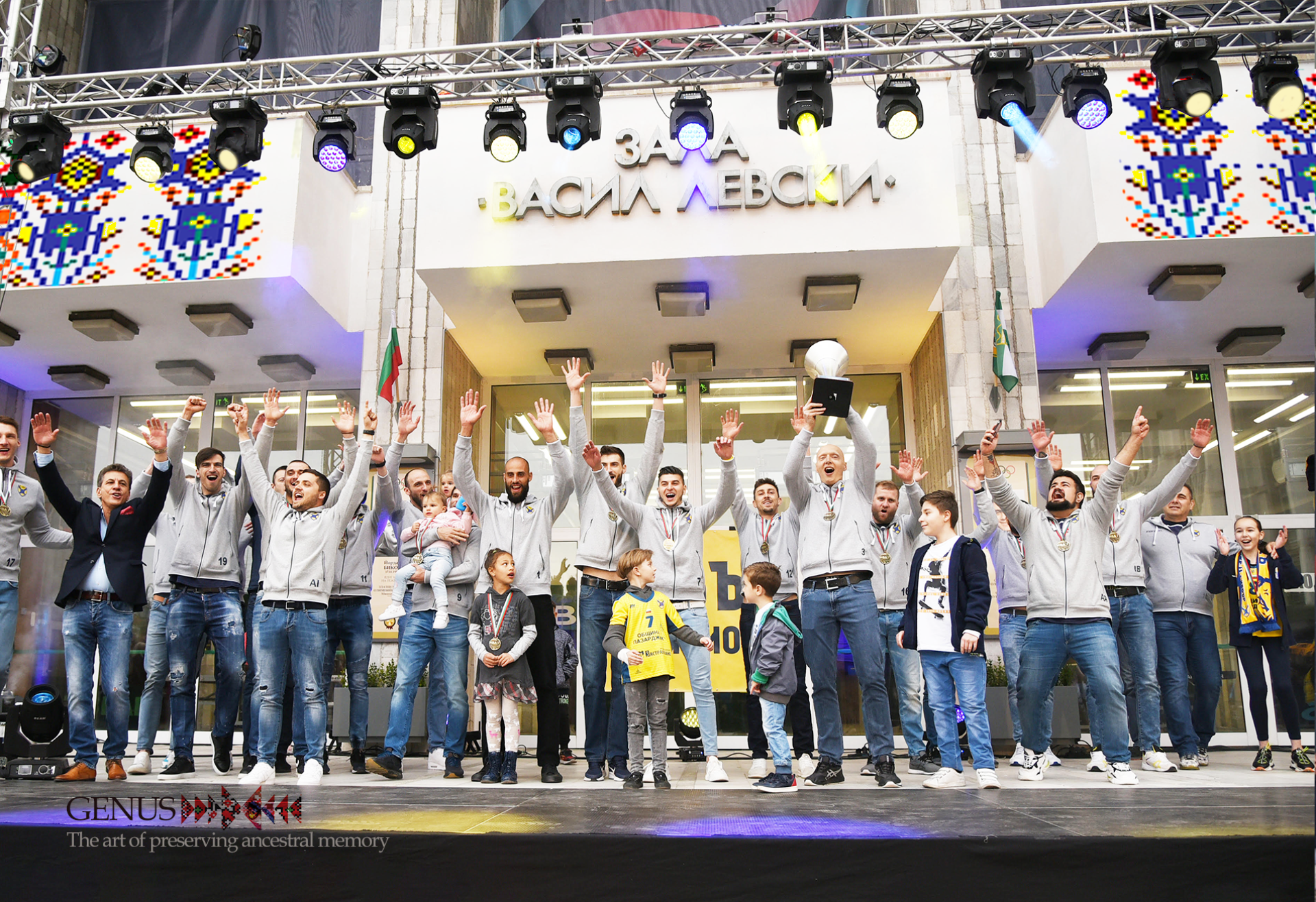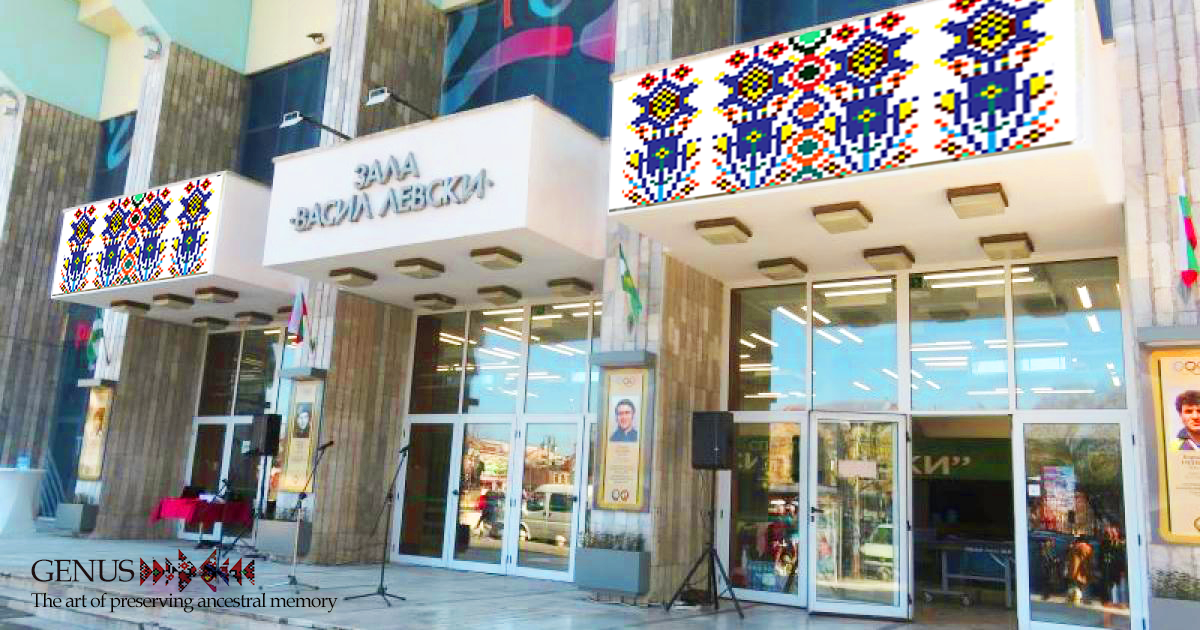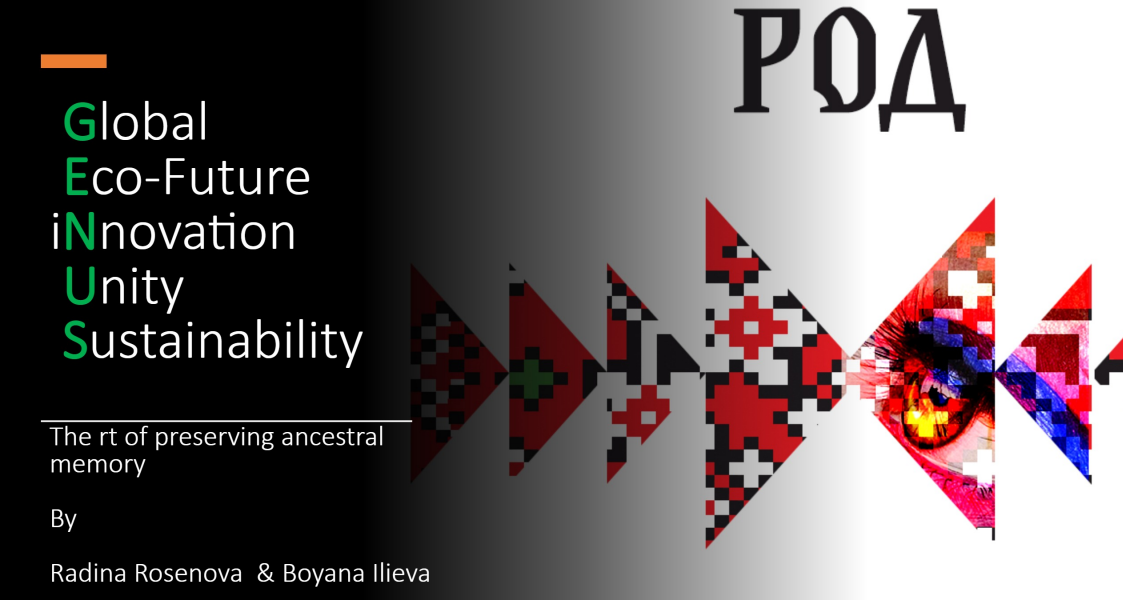GENUS
Basic information
Project Title
Full project title
Category
Project Description
The project consists of two exterior murals 20sq/m painted in rural and urban environment. We used eco-friendly paints and eco-friendly exterior panels (can be recycled) to paint on. We paint motifs inspired from traditional embroidery and the hand-woven Carpet-making (recognized by UNESCO for Intangible World Heritage. We declare that its possible for art to take new path in its eco-development and using the power of the ancient symbols GENUS aims to unite the new with the already established.
Geographical Scope
Project Region
Urban or rural issues
Physical or other transformations
EU Programme or fund
Which funds
Description of the project
Summary
GENUS The art of preserving ancestral memory consists of two murals illustrating Motifs from the craft of traditional embroidery - one in a rural and one in an urban environment (with a total size of 20sq/m). One of our goals is to show our example to artists around the world and to follow our example in solving important global ecological problems. During the implementation of the project we used environmentally friendly paints and materials (which can be recycled) so that there is no harm to nature, people and the climate. We responsibly declare that it is possible for art to take a new path in its development (street art, murals, graffiti) without the use of sprays, paints and materials that are harmful to the environment. It is also possible not to disturb the architecture and aesthetics of the buildings (direct application of sprays and paints on them), but to use eco-friendly exterior panels for painting that can be recycled. We choosed to paint on such - boards that do not contain formaldehyde and asbestos, silicon dioxide and ammonia, volatile organic compounds and toxic ingredients.
Authentic motifs are painted, which are inspired from both - the traditional embroidery craft and the traditional hand-woven carpets craft (Carpet-making In Chiprovtsi), which is recognized by UNESCO for Intangible World Heritage. For the authenticity of the motifs used from the region (Bulgaria consists of 28 regions) we met elderly women (keepers) who embroidered in their youth. They gladly shared their knowledge and experience and helped us to create the design.Thanks to the authentic motifs, the feeling of belonging to the younger generation and the elderly is restored.
Using the universal language of art, drawing strength and wisdom from the root, the GENUS project aims to unite the new with the already established. There is nothing more stable than the spirit, power and message hidden in the ancient symbols (ancient Bulgarian runes - which are the basis of embroidery).
Key objectives for sustainability
In this rapidly evolving dynamic world, it is vital to realize the importance of an ecologically clean and healthy environment. For us as artists, it is a priority, in addition to aesthetics, to contribute also to the elimination of harm to nature and people. As well as the European Union Members have included the environmental protection as priority in the Maastricht contract.
In the implementation of our project we have used environmentally/eco friendly paints and materials. The painting was made on environmentally/eco friendly exterior panels which do not contain formaldehyde and asbestos, silicon dioxide and ammonia, volatile organic compounds and toxic ingredients. We all strive for energy efficiency - a big advantage in the production of these panels is that only 25-50% of the energy are used for the production compearing to the energy neeed for the production of other panels. They are an innovation in architecture & building (30% lighter than others, fireproof and moisture resistant) but the best part is that they can be recycled.
The paints we used are also environmentally/eco friendly. They do not contain heavy metals or carcinogenic toxic substances and do not emit volatile aromatic carbohydrates when evaporated.
They do not contain dangerous for the environment respiratory or skin sensitizers, mutagenic or toxic to reproduction substances. The GENUS project is 100% environmentally friendly for its entire operational cycle (extraction-production-application-distribution and recycling) without compromising on quality.
It is time for art to take a new path in its development.
The path of its eco-development.
Key objectives for aesthetics and quality
The goal of the project is contribution through aesthetics for regaining a sense of belonging for the public spaces. Aesthetic perception is directly related to the field of reflection, in the sphere of emotions. The quality of experience is enhanced, because we have drawn embroideries (symbols related to the culture and identity of the local population, their spirit). Through his sences, the man creates a picture for the world. This picture is determined by the influence of the external environment. That is why we choose to share our message through drawing.
The art panels are installed in places that absolutely comply with the surrounding environment and contribute for the renovation of the building on which they are installed - small investment, maximum effect.
The colors are selected very carefully. In the urban environment, blue and yellow prevail, which perfectly fits into the general space, but also arouse people's interest .
In the rural (mountainous) area the red color prevail, as it contrasts perfectly with the green landscape.
The painted panels are functional for restoring the shape/appearance of a building (old or new), eco-friendly.
No serious interventions needed for the building's restoration.
Enormous historical heritage and traditions presented in a modern artistic way, which can not leave people indifferent.
Key objectives for inclusion
Our goal is to create the conditions for a positive exchange between generations. Using the universal language of art, we want to unite the new and the already established.
We aim to show through our example that there is an intersection point between elderly and youth. We pay attention to the unity, drawing strength and wisdom from the traditions, historical heritage and local crafts.
The project and its implementation is accessible to all. It is the participation of young and old in our activities that leads to inclusion. They gladly joined in with their unique knowledge and abilities, the elders provide us with authentic embroidery patterns that have preserved their work over the centuries, and the young people helped us to create a modern innovative design.
For easy access, we have chosen to install the project in central locations in the specified region.
We strive through a transdisciplinary approach (uniting youth and eldery) and absolute accessibility and affordability for all, to present a centuries-old craft and messages for continuity, to restore a sense of belonging and restore the pride of the local population.The places where the art panels are installed are constantly visited. In the urban environment we choosed a large sports hall, where children and adults train daily and competitions in various sports are held. The Bulgarian volleyball champions train and compete there. The art panels in the rural environment is installed between 4 important sites - a playground, a retirement club, a school and a kindergarten. The easy access and the strategic location contributes to the realization of continuity, where the elders introduce the younger ones to the embroideries, their symbolism and resilience over the centuries.It's our responsibility to preserve, decode and pass it on to future generations in an easy and accessible way. To use what connects us-our roots, to create the conditions for inclusion and to reconcile the youth with the wisdom of the years.
Results in relation to category
The results of the project exceeded our expectations. Media (newspapers, TV) at regional and national level have made and still make reports. We managed to combine sports with our rich cultural heritage. The volleyball team of our city is in the top 10 of the Champions League teams and we have many European teams visiting the sports hall (where the art panels are plced). The hall is also host for many competitions from the World Cup in sport dances.
The athletes themselves say that before entering training or competition, they feel inspired by the painted Bulgarian embroideries (drawing strength from the root and giving their best on the field). The impact of the embroideries is as strong as the national anthem. There is a huge variety of people who visit the sports hall. It is this admiration for our motives that is a cause for pride and a return to the sense of belonging to the local population.
For the Art Panel in the rural enviroment, we observe a natural connection between people, nature and folklore motifs. Young and elders take the initiative and organize many celebrations against the background of the painted motifs. Participants often share that they draw inspiration and strength from them. We are witnessing a phenomenon - building unique relationship between people, regardless of differences in age and interests - they are united by tradition. We observe that the feeling of pride returns in older women (inspired by GENUS), they take out of their wardrobes the traditional folk costumes they wore in their youth and on which the same embroideries can be seen embroidered (as painted on the panel). Once again, they feel useful to be able to pass on the knowledge of folklore and traditions to younger people by studying the motifs, traditional songs and dances together.
This togetherness is the real success for us.
How Citizens benefit
The project covers several stages of implementation. The first is the research of information on authentic motifs, which includes visits and meetings with people working in Ethnographic Museums and elderly women who embroidered in their youth and in their wardrobes there are still preserved authentic folk costumes. Information that includes the symbolism of the embrodied motif and the meaning its colors. We also learned from them that you can't embroider every day - of great importance was the position of the Moon and its cycles (surprisingly, they were aware with them): for example, they did not embroider symbols for love and fertility in the waning moon. In order to involve the young people in this idea, we turned to them for the preparation of a modern design based on the authentic one. The result was stunning.
The other stage is the technical implementation of the project, which includes meetings with specialists in the field of construction. The innovative approach in the production of environmentally friendly paints &sprays and environmentally friendly external panels for installation (suitable for art/painting). After a detailed description of their technical parameters and characteristics on their recommendation, we focused on the most suitable for our purpose - recyclable materials. The benefit of their participation in the project is huge - ecologically clean and healthy environment.
The next stage is our meeting with people from the local government, to whom we presented the project and after its consideration, they gladly allowed us to implement it on a public building. The benefit of cooperating with them is the implementation of a project that aims to return to tradition and involve people in them, aesthetically presented in the modern urban environment.
We managed to unite people of different ages, professions and positions in society and included them in our project, because each of us is aware of the need to preserve the spirit and traditions.
Physical or other transformations
Innovative character
One of the crafts that are the basis for the preservation of our traditions and folklore is embroidery. Very few people today know and master this knowledge. It is stored in Ethnographic Museums and by our grandmothers. Unfortunately, the fabric on which it is embroidered is difficult to store over time - it thins, breaks, the colors fade... That's why we decided to use an innovative approach to preserve and transmit these symbols, painting them on eco-panels and placing them in a common space easily accessible to all.
Through art we want to improve the aesthetics of a building (in particular the space around it) in any way not to destroy its integrity (facade), but moreover - to improve energy and efficiency by using recyclable ecopanels, which also serve for insulation.
Another part of the innovative nature of GENUS is its implementation with environmentally friendly paints and materials. It is time for art to take the path of its eco-future, a necessary vital step in human evolution.
We hope that everyone will follow our new eco-practice in art in common spaces (street art, murals, graffiti), as street art is one of the main polluters.
We believe that through our innovative approach we have found a solution to serious global problems.
Learning transferred to other parties
As more time passes, GENUS gathers more and more followers, through aesthetics, love of nature, innovation, awareness, spirit and its meaning, the project does not remain indifferent to people developing in different spheres of life. Every day thousands of people enjoy the art panels in the urban and rural environment and also increase the tourist interest in the location. Apart from the sense of belonging and pride of the local population, it is also very attractive and interesting to our guests. We, humans are the most effective way to spread the idea and methodology. In our modern world, social media is extremely useful for sharing public information, but it is very important for us not to lose the direct connection: man-art and personal contact with it. Anyone who has touched and seen this modern idea can read the information about the creation, the idea, the importance and the necessity of GENUS in the specified information installed next to the art eco-panel.
We already have many followers who embrace our innovative eco-idea of preserving and transmitting ancestral memory, renovating buildings without damaging their facades and at the same time increasing energy efficiency with recyclable materials.
The project has the potential to continue to develop at national level, due to the interest of people from different cities (near and far to our region).
We always talk openly about the steps needed to implement the project in front of media, newspapers and TV participations and thanks to this publicity and uniqueness of GENUS, we constantly receive inquiries about the methodology and innovative approach. There are many interested schools that need our knowledge to renovate their facades using an eco-approach - art created with harmless materials for students, nature and citizens.
We are proud of the solutions we found to global issues and it is extremely important for us to properly disseminate our methodology, for which we continue to work every day.

